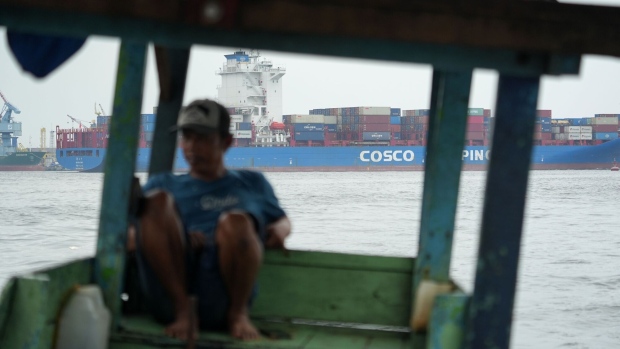May 6, 2024
Indonesia’s GDP Growth Accelerates to 5.11%, Beats Expectations
, Bloomberg News

(Bloomberg) -- Indonesia’s economy expanded faster than expected last quarter as holiday festivities and the government’s cash handouts supported consumer spending, even as risks loom over the outlook from slowing global demand and geopolitical uncertainties.
Gross domestic product rose 5.11% in the three months through March from a year ago, according to the statistics office on Monday. That was quicker than the median forecast of 5.08% growth seen by economists in a survey and marks the fastest first-quarter pace in a decade, based on data compiled by Bloomberg.
Compared with the previous three months, GDP declined 0.83% on a non-seasonally adjusted basis, narrower than the estimated 0.86% contraction.
The momentum in the economy provides room for Indonesia’s central bank to tighten monetary policy further if needed to support the rupiah, which has lost nearly 4% so far this year amid a stronger dollar. Bank Indonesia reiterated it was ready to do more to support the currency should the Federal Reserve delay its interest-rate cuts and fighting worsens in the Middle East.
The rupiah strengthened 0.38% to 16,023 against the greenback as of the noontime trading break in Jakarta. The benchmark stock index was up 0.23%.
Private consumption, which accounts for over half of the national output, remained the main driver of Southeast Asia’s largest economy as growth accelerated to 4.91%. This was spurred by celebration of the Ramadan holidays throughout March, a period that saw higher spending on food, beverage, transportation and communications.
Aside from the one-off boost from Ramadan occurring earlier than usual this year, PT Bank Danamon Indonesia economist Irman Faiz expects growth to face challenges from a higher-for-longer-rate environment as it could dampen global and domestic demand. He sees the nation’s negative export growth trend continuing throughout the year.
What Bloomberg Economics Says...
“The sharper-than-expected pickup in Indonesia’s first-quarter growth — driven by government and household spending — looks to be just a temporary spurt. For one, the surge in public spending was a one-off — due to the election in February.”
— Tamara Mast Henderson, economist
For the full note, click here
Investment was the second-largest contributor to growth in the first quarter driven by capital goods and building construction. It expanded 3.79%, albeit at a slower pace than the previous three-month period amid interest rate at a five-year high.
A government spending spree sent public consumption soaring nearly 20% — its best print since data going back to 2006. Indonesia distributed cash aid for low-income households and raised salaries for civil workers last quarter. Campaign spending also ramped up ahead of the national elections in February.
Meanwhile, exports grew just 0.5% last quarter as a sluggish global economy weighed on both the price and demand for key Indonesian commodities such as iron, steel, coal and palm oil.
“Amid falling prices for key export commodities, Indonesia’s economy grew solid in the first quarter, supported by strong domestic economic activity, said BPS acting head Amalia Adininggar Widyasanti at a briefing Monday.
Other highlights:
- Highest first-quarter GDP growth prints were seen in the areas of Maluku, Papua and Sulawesi mainly driven by the local mining, metal industry, as well as in Kalimantan with the construction of the new capital
- Indonesia’s unemployment rate fell to 4.82% in February from 5.45% a year ago. There were 7.2 million unemployed people, down from 7.99 million
--With assistance from Tomoko Sato and Norman Harsono.
(Updates throughout with more details)
©2024 Bloomberg L.P.






